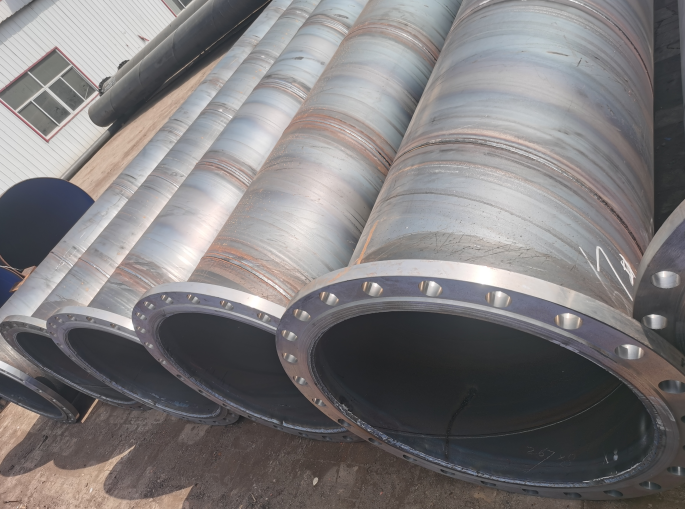
Spiral Steel Pipe Connection Methods and their Respective Advantages
1. Flange connection
Flange connection is a commonly used connection method for spiral steel pipes. It is suitable for pipes with high temperature, high pressure, high corrosion, and pipes that need to be frequently disassembled and repaired. Flange connection has a simple structure, high reliability, easy installation and maintenance, and is a relatively common connection method.

Flange connection is a commonly used mechanical connection method. When making flange connections, it is necessary to install a flange on one end of the spiral steel pipe and a corresponding flange joint on the other end, and then connect the two flanges with bolts to form a sealed pipe connection. The advantages of flange connection are:
a. Good sealing: Flanges and bolts can effectively ensure the sealing of the pipeline and prevent media leakage.
b. Easy to disassemble: The flange connection is easy to disassemble and repair, making it convenient to replace pipes or repair equipment.
c. Wide range of application: suitable for spiral steel pipes of various shapes and sizes, including straight pipes, elbows, tees, etc.
2. Direct connection (also called welding connection)
Direct connection is to directly weld two spiral pipes together. This connection method is suitable for general occasions where spiral steel pipes are used to transport liquids or gases. Since direct connection is used, attention should be paid to foundation settlement when using it to avoid pipe deformation. When making welding connections, qualified welding materials and skilled welding techniques are required to ensure welding quality and safety. The advantages of welded connections are:
a. Firm connection: During welding, the edges of the spiral steel pipe are melted and reconnected to form a smooth weld, thereby ensuring the sealing and strength of the pipe.
b. Wide range of application: suitable for spiral steel pipes of various shapes and sizes, including straight pipes, elbows, tees, etc.
c. Strong corrosion resistance: The welded spiral steel pipes can effectively prevent pipeline corrosion after being coated with anti-corrosion materials.
3. Socket connection
The socket-type connection is to match the outer diameter and inner diameter of the two pipes and then tighten them with steel bars or steel sleeves. The socket-type connection is suitable for situations where the pipe diameters are the same and the wall thickness is not large. The advantage is that it is easy to construct, but the disadvantage is that leakage problems are prone to occur at the interface.
Socket connection is a commonly used connection method for plastic pipes. When making a socket connection, one end of the spiral steel pipe needs to be inserted into the socket, and then the other end is sealed to form a sealed pipe connection. The advantages of socket connections are:
a. Convenient construction: The socket connection is easy to construct and can be quickly installed and disassembled.
b. Good sealing: The socket connection is sealed with a sealing rubber ring, which can effectively ensure the sealing of the pipeline.
c. Strong corrosion resistance: After the spiral steel pipes with socket connections are coated with anti-corrosion materials, they can effectively prevent pipeline corrosion.
4. Lap connection
The overlapping connection is to thin the wall thickness of the spiral steel pipe, then overlap the two pipes and then fix them with steel wire binding or welding. This connection method is suitable for situations where the pipe diameter is large and the quality is relatively high, but the installation is difficult and requires strict mastery of construction technology.
Conclusion:
The above are 4 common connection methods for spiral steel pipes. Different connection methods are suitable for different occasions and requirements. Choosing the appropriate connection method can improve the service life and safety performance of spiral steel pipes. In practical applications, it is necessary to carefully analyze the specific situation and select the appropriate connection method. At the same time, corresponding safety measures and quality control measures need to be taken during the construction process to ensure construction quality and safety.
Expanded information:
Flange connection spiral steel pipe:
The flange-type spiral steel pipe is made by welding a flange to both ends of the spiral steel pipe. It has the characteristics of convenient connection, convenient installation and strong adaptability. Can adapt to various special and complex working environments or terrains. But its disadvantage is that compared with ordinary welding connection methods, its price is relatively high.
Flange-type spiral steel pipes are often used for surface-mounted pipes. In order to improve the corrosion resistance of the inner and outer walls of the steel pipe and increase its service life, anti-corrosion processing is required. For example, polyurethane anti-corrosion, fiberglass anti-corrosion, plastic coating anti-corrosion, etc. The plastic coating anti-corrosion method is a new anti-corrosion method that has emerged rapidly in recent years.
Flange-type spiral steel pipes are suitable for urban water supply pipelines, drainage pipelines, and gas pipelines. Also suitable for petroleum, chemical, coal, mining, transportation and other industries. Due to its strong adaptability, easy installation, high strength, good anti-corrosion performance, reduced construction period and other characteristics, it plays an important role in various industries of modern construction and is an important pipeline material worthy of promotion.
Read more: Spiral Welded Pipe Manufacturing Process


